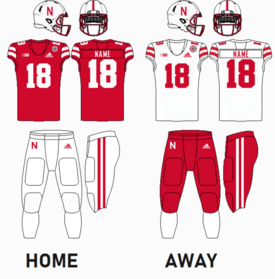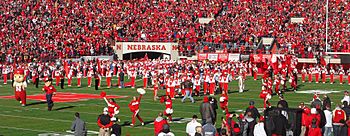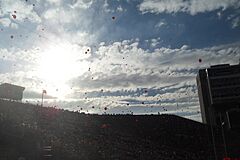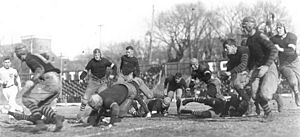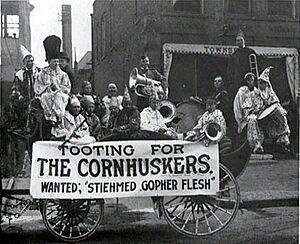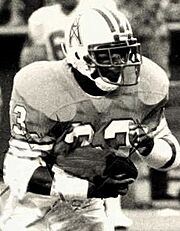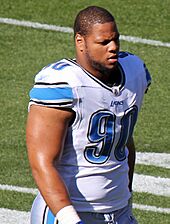Nebraska Cornhuskers football facts for kids
Quick facts for kids Nebraska Cornhuskers football |
|
|---|---|
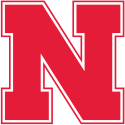 |
|
| First season | 1890; 135 years ago |
| Athletic director | Troy Dannen |
| Head coach | Matt Rhule 3rd season, 12–13 (.480) |
| Stadium | Memorial Stadium (Capacity: 85,458) |
| Field surface | FieldTurf |
| Location | Lincoln, Nebraska |
| NCAA division | Division I FBS |
| Conference | Big Ten Conference |
| Past conferences | WIUFA (1892–1897) MVIAA / Big Eight (1907–1918, 1921–1995) Big 12 (1996–2010) |
| All-time record | 924–430–40 (.677) |
| Bowl record | 27–27 (.500) |
| Claimed nat'l titles | 5 (1970, 1971, 1994, 1995, 1997) |
| Unclaimed nat'l titles | 7 (1915, 1980, 1981, 1982, 1983, 1984, 1993) |
| National finalist | 2 (1993, 2001) |
| Conference titles | 46 |
| Division titles | 10 |
| Rivalries | Colorado (rivalry) Iowa (rivalry) Iowa State (rivalry) Kansas (rivalry) Kansas State (rivalry) Miami (FL) (rivalry) Minnesota (rivalry) Missouri (rivalry) Oklahoma (rivalry) Wisconsin (rivalry) |
| Heisman winners | Johnny Rodgers – 1972 Mike Rozier – 1983 Eric Crouch – 2001 |
| Consensus All-Americans | 54 |
| Current uniform | |
| Colors | Scarlet and Cream |
| Fight song | Hail Varsity |
| Mascot | Herbie Husker Lil' Red |
| Marching band | Cornhusker Marching Band |
| Outfitter | Adidas |
| Website | huskers.com |
The Nebraska Cornhuskers football team represents the University of Nebraska–Lincoln in college football. They play in the NCAA Division I Football Bowl Subdivision and are part of the Big Ten Conference. The team's home games are held at Memorial Stadium in Lincoln, Nebraska. They have played there since 1923. Since 1962, every game at Memorial Stadium has been completely sold out.
Nebraska is one of the most famous college football teams. They have the eighth-highest number of wins among all FBS teams. The Cornhuskers have won 46 conference championships. They also have five official national championships. These were in 1970, 1971, 1994, 1995, and 1997. Their teams from 1971 and 1995 are thought to be among the best ever.
Three players from Nebraska have won the Heisman Trophy. These are Johnny Rodgers, Mike Rozier, and Eric Crouch. Twenty-four other Cornhuskers are in the College Football Hall of Fame.
The team first became very successful in the early 1900s. Between 1900 and 1916, they had five seasons where they didn't lose any games. They also had a streak of 34 games without a loss. Nebraska won 24 conference championships before World War II. However, they struggled after the war until Bob Devaney became coach in 1962.
Devaney made Nebraska a national powerhouse. He won two national championships and eight conference titles in 11 seasons. Tom Osborne, who was the offensive coordinator, took over as head coach in 1973. For the next 25 years, he became one of the best coaches in college football. He was known for his I formation offense and new training programs. After Osborne retired in 1997, Nebraska had five different head coaches. Matt Rhule was hired in 2023.
Contents
Team History
The Nebraska Cornhuskers football team has a long and interesting history. Their journey began in 1890. Over the years, they have been part of different conferences.
Conference Changes
- Independent (1890–1891, 1898–1906, 1919–1920)
- Western Interstate University Football Association (1892–1897)
- Missouri Valley Intercollegiate Athletic Association / Big Eight Conference (1907–1918, 1921–1995)
- Big 12 Conference (1996–2010)
- North Division
- Big Ten Conference (2011–present)
- Legends Division (2011–2012)
- West Division (2013–2023)
Coaching Legends
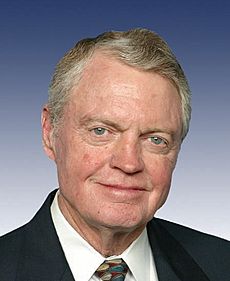
Nebraska has had 31 head coaches in its history. Eight of them are in the College Football Hall of Fame. These include Edward N. Robinson, Fielding H. Yost, Dana X. Bible, Biff Jones, Pete Elliott, Bob Devaney, Tom Osborne, and Frank Solich. Tom Osborne has the most wins for the program. He also has the fifth-highest winning percentage in major college football history.
The team's first official head coach was Frank Crawford in 1893. In the early 1900s, Nebraska became a strong regional team under Walter C. Booth. They had a 24-game winning streak from 1901 to 1904. In 1911, Ewald O. "Jumbo" Stiehm became the first full-time coach. He lost only two games in five seasons. His 1915 team, which went 8–0, was later recognized as a national champion.
Dana X. Bible and Biff Jones led Nebraska to eight conference championships in the 1920s and 1930s. Jones also took the team to its first bowl game. After World War II, the team struggled until Bob Devaney was hired in 1962. Devaney quickly made Nebraska a national power. He won national championships in 1970 and 1971.
Tom Osborne took over from Devaney in 1973. He coached for 25 years and became one of college football's greatest coaches. His teams always won at least nine games. They were nationally ranked for almost all of his games. Osborne finally won his first major national championship in 1994. He retired in 1997 after winning two more titles. He handed the team over to his assistant, Frank Solich.
Solich led Nebraska to the 2002 BCS National Championship Game. However, he was fired in 2003 after a 7–7 season. After that, Bill Callahan coached for four years. Then Bo Pelini took over. Pelini won at least nine games in each of his seven seasons. But he often had disagreements with the school. He was fired in 2014. Nebraska had a tough eight years under Mike Riley and Scott Frost. Then Matt Rhule was hired in 2023.
Championship Wins
National Titles
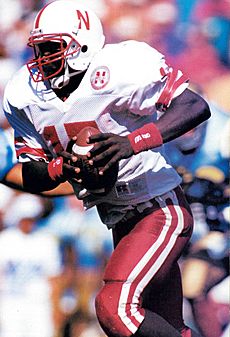
Nebraska claims five national championships. These were awarded by major polls like the AP poll or the Coaches poll.
1970 and 1971 Championships
Nebraska's first titles came less than 10 years after Bob Devaney became coach. In 1970, quarterbacks Jerry Tagge and Van Brownson led the team to nine wins in a row. After other top teams lost, Nebraska won the national title. They beat LSU 17–12 in the Orange Bowl.
In 1971, Nebraska was the number one team for most of the season. They won their first 11 games by at least 24 points. This set up a huge game against number two Oklahoma on Thanksgiving Day. This game was called "The Game of the Century." Nebraska's strong defense played against Oklahoma's powerful offense. Nebraska won 35–31. About 55 million people watched the game, making it the most-watched college football game ever. Nebraska then beat Alabama 38–6 in the Orange Bowl. This made them national champions again. Their 1971 team is considered one of the best in college football history.
1994, 1995, and 1997 Championships
After many close calls, Tom Osborne finally won his first national championship in 1994. Star quarterback Tommie Frazier was out for part of the season. Backup Brook Berringer led Nebraska to an undefeated regular season. Frazier returned for the 1995 Orange Bowl against Miami. Nebraska won 24–17, giving Osborne his first title.
In 1995, Frazier and freshman Ahman Green led the team through a tough season. They beat three top-ten teams in four weeks. Nebraska then crushed Florida 62–24 in the 1996 Fiesta Bowl. Frazier ran for 199 yards and was named the best player in his third straight national championship game. The 1995 Nebraska team is also considered one of the best ever. They set a record by scoring 53.2 points per game. They are the only national champion to win every game by at least 14 points.
In 1997, Nebraska started outside the top five. But quarterback Scott Frost led them to a win against number two Washington. They had a very close game against Missouri in November. Nebraska won in overtime after a famous play called the "Flea Kicker." A month later, Nebraska won its first Big 12 title. They beat Texas A&M 54–15. Nebraska then beat Tennessee 42–17 in the 1998 Orange Bowl. This was the official national championship game. Nebraska narrowly passed Michigan in the Coaches poll to win its third national title in four years.
| Year | Coach | Record | Bowl | Result | Final AP | Final Coaches |
|---|---|---|---|---|---|---|
| 1970 | Bob Devaney | 11–0–1 | Orange | W 17–12 vs. LSU | No. 1 | No. 3 |
| 1971 | 13–0 | Orange | W 38–6 vs. Alabama | No. 1 | ||
| 1994 | Tom Osborne | 13–0 | Orange (BC NCG) | W 24–17 vs. Miami (FL) | ||
| 1995 | 12–0 | Fiesta (BA NCG) | W 62–24 vs. Florida | |||
| 1997 | 13–0 | Orange (BA NCG) | W 42–17 vs. Tennessee | No. 2 |
Other National Titles
Nebraska has also been awarded seven other national championships by major selectors. However, the school does not officially claim these titles.
| Year | Coach | Record | Bowl | Result | Final AP | Final Coaches | Selector |
|---|---|---|---|---|---|---|---|
| 1915 | Ewald O. Stiehm | 8–0 | None | N/A | BR | ||
| 1980 | Tom Osborne | 10–2 | Sun | W 31–17 vs. Mississippi State | No. 7 | No. 7 | FACT |
| 1981 | 9–3 | Orange | L 22–15 vs. Clemson | No. 11 | No. 9 | NCF | |
| 1982 | 12–1 | Orange | W 21–20 vs. LSU | No. 3 | No. 3 | B(QPRS) | |
| 1983 | 12–1 | Orange | L 31–30 vs. Miami (FL) | No. 2 | No. 2 | B(QPRS), DeS, FACT, L, MGR, PS, SR | |
| 1984 | 10–2 | Sugar | W 28–10 vs. LSU | No. 4 | No. 3 | L | |
| 1993 | 11–1 | Orange (BC NCG) | L 18–16 vs. Florida State | No. 3 | NCF | ||
Conference Championships
Nebraska has won 46 conference championships. This is the second-most of any FBS school. Their first titles were in the Western Interstate University Football Association. This was one of college football's first conferences. Nebraska was part of it for six seasons.
The conference ended in 1897. Nebraska then played as an independent team for 10 years. In 1907, the Missouri Valley Intercollegiate Athletic Association was formed. Nebraska was very strong in the MVIAA early on. They won 21 titles before 1940. After Biff Jones left for World War II, the team went 22 seasons without a conference championship.
Bob Devaney was hired in 1962. He quickly ended Nebraska's dry spell. He won eight titles in 11 years as head coach. Tom Osborne took over in 1973 and won 13 conference championships. The game between Nebraska and Oklahoma on Thanksgiving weekend often decided the Big Eight championship. These two schools won most of the conference titles in its last 36 years. Nebraska won the second Big 12 Championship Game in 1997, which was Osborne's last season. They won it again two years later.
| Year | Coach | Overall | Conference | |||||
|---|---|---|---|---|---|---|---|---|
| WIUFA (1892–1897) | ||||||||
| 1894† | Frank Crawford | 6–2 | 2–1 | |||||
| 1895† | Charles Thomas | 6–3 | 2–1 | |||||
| 1897 | Edward N. Robinson | 5–1 | 3–0 | |||||
| MVIAA / Big Eight Conference (1907–1918, 1921–1995) | ||||||||
| 1907† | William C. Cole | 8–2 | 1–0 | |||||
| 1910 | 7–1 | 2–0 | ||||||
| 1911† | Ewald O. Stiehm | 5–1–2 | 2–0–1 | |||||
| 1912† | 7–1 | 2–0 | ||||||
| 1913† | 8–0 | 3–0 | ||||||
| 1914 | 7–0–1 | 3–0 | ||||||
| 1915 | 8–0 | 4–0 | ||||||
| 1916 | E. J. Stewart | 6–2 | 3–1 | |||||
| 1917 | 5–2 | 2–0 | ||||||
| 1921 | Fred Dawson | 7–1 | 3–0 | |||||
| 1922 | 7–1 | 5–0 | ||||||
| 1923 | 4–2–2 | 3–0–2 | ||||||
| 1928 | Ernest Bearg | 7–1–1 | 4–0 | |||||
| 1929 | Dana X. Bible | 4–1–3 | 3–0–2 | |||||
| 1931 | 8–2 | 5–0 | ||||||
| 1932 | 7–1–1 | 5–0 | ||||||
| 1933 | 8–1 | 5–0 | ||||||
| 1935 | 6–2–1 | 4–0–1 | ||||||
| 1936 | 7–2 | 5–0 | ||||||
| 1937 | Biff Jones | 6–1–2 | 3–0–2 | |||||
| 1940 | 8–2 | 5–0 | ||||||
| 1963 | Bob Devaney | 10–1 | 7–0 | |||||
| 1964 | 9–2 | 6–1 | ||||||
| 1965 | 10–1 | 7–0 | ||||||
| 1966 | 9–2 | 6–1 | ||||||
| 1969† | 9–2 | 6–1 | ||||||
| 1970 | 11–0–1 | 7–0 | ||||||
| 1971 | 13–0 | 7–0 | ||||||
| 1972 | 9–2–1 | 5–1–1 | ||||||
| 1975† | Tom Osborne | 10–2 | 6–1 | |||||
| 1978† | 9–3 | 6–1 | ||||||
| 1981 | 9–3 | 7–0 | ||||||
| 1982 | 12–1 | 7–0 | ||||||
| 1983 | 12–1 | 7–0 | ||||||
| 1984† | 10–2 | 6–1 | ||||||
| 1988 | 11–2 | 7–0 | ||||||
| 1991† | 9–2–1 | 6–0–1 | ||||||
| 1992 | 9–3 | 6–1 | ||||||
| 1993 | 11–1 | 7–0 | ||||||
| 1994 | 13–0 | 7–0 | ||||||
| 1995 | 12–0 | 7–0 | ||||||
| Big 12 Conference (1996–2010) | ||||||||
| 1997 | Tom Osborne | 13–0 | 8–0 | |||||
| 1999 | Frank Solich | 12–1 | 7–1 | |||||
† Co-champion
Division Championships
Nebraska has won 10 division championships. Nine were in the Big 12's North Division. Nebraska played in this division from 1996 until they left for the Big Ten in 2011. The Big Eight conference never used divisions.
Nebraska won one division title in the Big Ten. This was across 13 seasons in the Legends Division and West Division. The Big Ten stopped using divisions in 2024.
| Year | Coach | Overall | Conference | Conference championship game | ||||
|---|---|---|---|---|---|---|---|---|
| Big 12 Conference (North Division) (1996–2010) | ||||||||
| 1996 | Tom Osborne | 11–2 | 8–0 | L 37–27 vs. Texas | ||||
| 1997 | 13–0 | 8–0 | W 54–15 vs. Texas A&M | |||||
| 1999 | Frank Solich | 12–1 | 7–1 | W 22–6 vs. Texas | ||||
| 2000† | 10–2 | 6–2 | Lost tiebreaker to Kansas State | |||||
| 2001† | 11–2 | 7–1 | Lost tiebreaker to Colorado | |||||
| 2006 | Bill Callahan | 9–5 | 6–2 | L 21–7 vs. Oklahoma | ||||
| 2008† | Bo Pelini | 9–4 | 5–3 | Lost tiebreaker to Missouri | ||||
| 2009 | 10–4 | 6–2 | L 13–12 vs. Texas | |||||
| 2010† | 10–4 | 6–2 | L 23–20 vs. Oklahoma | |||||
| Big Ten Conference (Legends Division) (2011–2013) | ||||||||
| 2012 | Bo Pelini | 10–4 | 7–1 | L 70–31 vs. Wisconsin | ||||
† Co-champion
Bowl Games
Nebraska has played in 54 bowl games. They had a record of 27 wins and 27 losses. From 1969 to 2003, they played in 35 bowl games in a row. This is a record.
In 1915, Nebraska was invited to the second bowl game ever. But university officials thought it was too expensive to send the team. Nebraska played its first bowl game in the 1941 Rose Bowl. They lost to Stanford.
Bob Devaney's first season ended with the team's first bowl victory. They beat Miami 36–34 in the 1962 Gotham Bowl. Three years later, Nebraska played Alabama in the 1966 Orange Bowl. Alabama won 39–28.
Nebraska did not play in a bowl game in 1967 or 1968. But they returned in 1969 and started their record streak. They won eight of their first nine bowl games during this time. This included two national championships. Nebraska often played in the Orange Bowl because of the Big Eight's bowl agreements. Their loss to Miami in the 1983 Orange Bowl is considered one of college football's greatest games.
Nebraska lost seven straight bowl games during Tom Osborne's time. Many of these were against teams from the Southeast. After a close championship game loss in 1993, Osborne won his first national title in 1994. He retired after taking Nebraska to seven straight major bowl games. The team's long bowl streak continued under Frank Solich. But it ended in 2004.
Nebraska did not play in a bowl game in 2017. This was the first time in 10 years. They then went seven years without a bowl game. This included all of Scott Frost's time as head coach. Nebraska returned to a bowl game in 2024.
Home Stadiums
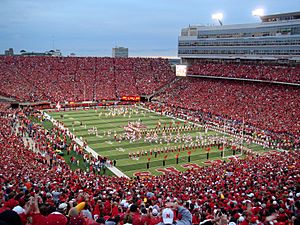
Nebraska Field
Before 1908, Nebraska played home games at Antelope Field. This was a temporary football field. In 1909, Nebraska Field opened. It had a wooden grandstand and bleachers.
Nebraska had a great record of 28 wins, 0 losses, and 2 ties at Nebraska Field under Jumbo Stiehm. By 1915, people wanted a new, stronger stadium. Nebraska Field was torn down in early 1923. Memorial Stadium was built on the same spot. The last game at Nebraska Field was a 14–6 win over Notre Dame in 1922.
Memorial Stadium
Memorial Stadium, also called "The Sea of Red," has been Nebraska's home since 1923. The university started planning a new stadium after World War I. Construction began in mid-1923. The stadium was dedicated to honor Nebraskans who served in wars.
The unfinished Memorial Stadium opened on October 13, 1923. It had a capacity of 31,080. This capacity stayed the same for decades. Between 1999 and 2013, major expansions increased the capacity to 85,458. The stadium is now completely enclosed.
Nebraska has sold out 403 consecutive games at Memorial Stadium. This is an NCAA record for any sport. It dates back to 1962. In 2023, Memorial Stadium hosted "Volleyball Day in Nebraska." The attendance was 92,003. This was a stadium record and the highest ever for a women's sporting event. Memorial Stadium is often listed as one of the best college football venues.
Team Traditions
Game Day Traditions
Since 1993, Nebraska's home games start with the "Tunnel Walk." The team runs onto the field, usually to the song "Sirius" by Alan Parsons Project. Before the Tunnel Walk, fans do a "Husker Power" chant. Half the crowd yells "Husker" and the other half yells "Power."
The Cornhusker Marching Band performs before every home game. They are called "The Pride of All Nebraska." As part of their show, the band plays the visiting team's fight song. The announcer says, "We welcome our friends from [school’s name]."
Fans at Memorial Stadium have released red helium balloons when Nebraska scores its first points. This tradition started in the 1960s. However, it was paused in 2012 and 2022 due to helium shortages and environmental worries. The crowd at Memorial Stadium also usually claps for the visiting team as they leave the field, no matter who won.
Walk-on Program
Nebraska started accepting walk-ons in the early 1960s. An official program began in 1973. This was when the NCAA reduced the number of scholarships teams could offer. Nebraska's teams often had many walk-on players.
Coach Tom Osborne believed walk-ons helped the team. He gave them the same access to training and academic help as scholarship players. Six former Nebraska walk-ons have become All-Americans. Twenty-five have been drafted into the National Football League. The NCAA started limiting roster sizes in 2024. This changed how traditional walk-on programs work.
Uniform History
Helmets
Nebraska used plain white or red helmets as early as 1930. A single stripe was added in 1953. Jersey numbers were put on helmets in 1957. In the 1960s, red helmets were removed. The numbers were replaced by a red "NU." In 1970, a shortage of "U" stickers led to using just a single "N." This change became permanent after a national championship season. The helmet design has stayed the same since, except for the facemask color.
Jerseys
In its early days, Nebraska often changed jersey designs and colors. They were usually red or scarlet. Sometimes they had a single "N" on the chest. But a consistent design wasn't used until numbers were added in 1933.
Small sleeve stripes were added in 1946. They got bigger in the late 1950s. From 1980 to 1983, Nebraska's jerseys only had an "N" on the sleeves. Stripes and TV numbers were added back permanently in 1984. In 1989, a patch was added to the left shoulder. It said "Nebraska Football: A Winning Tradition." Player last names appeared on jerseys for bowl games starting in 1971. They were on road jerseys in 1980. But home jerseys only had names for seniors playing their last home game. Last names were put on all jerseys permanently in 1988.
Nebraska's defense is often called the "Blackshirts." This is because starting defensive players wear black jerseys during practice. This tradition started in 1964. Coach Bob Devaney wanted an easy way to tell different units apart. Blackshirts are often shown with a skull and crossbones.
Pants
Nebraska's pants had two stripes down each side from 1968 to 1994. These were removed in 1995. In 2002, Nebraska had large side panels on its jerseys and pants. They wore all-white in every road game. Fans did not like these changes. Most were changed back, and pant stripes returned. Pant stripes were removed again during Scott Frost's time as coach. They returned under Matt Rhule.
Nebraska usually wears white pants at home and red on the road. There have been rare exceptions. The team wore red pants with red jerseys in 1986 against Oklahoma. But they lost, so that combination was stopped. Nebraska first wore all-white uniforms in the 1991 Florida Citrus Bowl. They lost three of these games. These "surrender suits" have been used sometimes since then.
Alternate Uniforms
The first time Nebraska wore non-standard uniforms was in 1920. They had to wear blue practice jerseys because South Dakota mistakenly brought their home red jerseys. Three years later, Nebraska wore blue again against Oklahoma. This was in the first game ever at Memorial Stadium. Nebraska celebrated the stadium's 100th anniversary in 2023. They wore blue-trimmed jerseys for the occasion.
Nebraska has worn alternate uniforms for one game in most seasons since 2009. Many of these were throwback uniforms. They honored past events or championships. Nebraska and Wisconsin played the first "Adidas Unrivaled" game in 2012. Both teams wore uniforms with block letters instead of front numbers. Nebraska wore other alternate designs several times. This included Blackshirts-themed uniforms in 2019 and 2020.
Adidas has been Nebraska's official uniform sponsor since 1996. In 2017, the school and Adidas signed a big deal for 11 years.
Team Rivalries
Colorado Buffaloes
Nebraska and Colorado first played on November 17, 1898. Nebraska won 23–10. They started playing regularly when Colorado joined the MVIAA in 1948. A bison head trophy called Mr. Chip was given to the winner in the 1950s. The rivalry became more intense in 1982. Coach Bill McCartney said Nebraska was Colorado's main rival. Colorado then started beating Nebraska.
Colorado became Nebraska's traditional Thanksgiving weekend opponent in 1996. This was when the Big 12 was formed. Nebraska won nine straight games against Colorado in the 1990s. Colorado ended this streak in 2001 with a 62–36 win over number one Nebraska. This led to a BCS controversy. One-loss Nebraska was chosen for the national championship game over two-loss Colorado. The teams no longer play every year. But they have met four times since leaving the Big 12 in 2010. Colorado rejoined the Big 12 in 2024.
Nebraska leads the series 50–21–2. No future games are planned.
Iowa Hawkeyes
Nebraska and Iowa first played on November 26, 1891. Iowa won 22–0. A year later, both schools were founding members of the Western Interstate University Football Association. They played every year until Iowa joined the Big Nine in 1900. Because it was easy to travel between Lincoln and Iowa City, Nebraska and Iowa played regularly as non-conference opponents until after World War II.
Nebraska won five of only six games in the series from 1947 to 2010. However, a 10–7 upset win by Iowa over number seven Nebraska in 1981 was important for Iowa's team. The teams have played every year for the Heroes Trophy since Nebraska joined the Big Ten in 2011.
After the Big Ten expanded in 2024, Iowa is Nebraska's only permanent conference opponent. Nebraska leads the series 30–22–3. Iowa holds the Heroes Trophy after their 2024 win. The teams will play next on November 28, 2025.
Iowa State Cyclones
Nebraska and Iowa State first played on November 19, 1896. Nebraska won 12–4. Both schools were founding members of the Missouri Valley Intercollegiate Athletic Association (later the Big Eight) in 1907. From 1926 to 2010, the two schools played each other every year.
Nebraska has mostly dominated this series. Their biggest win over Iowa State was 77–14 in 1997. This was when Tom Osborne won his last national title. The series ended in 2010 when Nebraska joined the Big Ten. Nebraska won the last game 31–30 in overtime.
Nebraska leads the series 85–18–2. No future games are planned.
Kansas Jayhawks
Nebraska and Kansas first played on November 12, 1892. Kansas won 12–0. Both schools were founding members of the WIUFA in 1892 and the MVIAA (later the Big Eight) in 1907. Nebraska and Kansas played every season from 1906 to 2010. This was once the longest uninterrupted streak in Division I.
Nebraska mostly dominated the series, especially later on. They won 36 straight games from 1969 to 2004. This is the second-longest win streak over an opponent in college football history. The series ended when Nebraska joined the Big Ten in 2010. Kansas also wanted to join but was not accepted.
Nebraska leads the series 91–23–3. No future games are planned.
Kansas State Wildcats
Nebraska and Kansas State first played on October 14, 1911. Nebraska won 59–0. Kansas State joined the MVIAA in 1913. They once threatened not to play a game in Lincoln because of a black player on Nebraska's team. But Nebraska denied any such rule, and the game was played.
Nebraska dominated the rivalry for most of its history. But the series became more competitive when KSU hired Bill Snyder. Kansas State never beat Tom Osborne. But they ended their 29-year losing streak to Nebraska after he retired. Number two Kansas State's 40–30 win in 1998 was one of their biggest wins ever. KSU beat Nebraska four more times before Nebraska left the Big 12 in 2010. These two schools were the closest rivals in the Big Eight and Big 12.
Nebraska leads the series 78–15–2. No future games are planned.
Miami (FL) Hurricanes
Nebraska and Miami first played on November 30, 1951. Miami won 19–7. Nebraska beat Miami for its first bowl victory in the 1962 Gotham Bowl. This was the first of six bowl games between the teams. The 1984 Orange Bowl was a very famous game. It was like a national championship game. Nebraska was down most of the game. They scored with less than a minute left to make it 31–30. Instead of tying the game, Tom Osborne went for a two-point conversion to win. But the pass was incomplete, and Miami won its first title. Miami then became a very strong team. They beat Nebraska in the 1989 and 1992 Orange Bowl.
The teams met again in the 1995 Orange Bowl. This was another national championship game. Tommie Frazier led two touchdown drives in the fourth quarter. This gave Osborne his first national title. Seven years later, Nebraska was chosen to play Miami in the 2002 BCS national championship game. Miami won 37–14.
The series is tied 6–6. No future games are planned.
Minnesota Golden Gophers
Nebraska and Minnesota first played on November 29, 1900. Minnesota won 20–12. The teams played every year until 1913. Minnesota's coach stopped the series because he was upset with Nebraska. It started again in 1932. Minnesota dominated until Bob Devaney became Nebraska's coach in 1962. Nebraska then won 16 straight games against Minnesota. This included an 84–13 win in Minneapolis in 1983.
The teams have played regularly since Nebraska joined the Big Ten in 2011. In 2014, the $5 Bits of Broken Chair Trophy was created. This came from a Twitter conversation between Minnesota's mascot and a funny fan account. After being shown on the field in 2014 and 2015, the trophy disappeared. It was brought back by fans as a fundraiser for children's hospitals.
Minnesota leads the series 37–25–2. Minnesota holds the $5 Bits of Broken Chair Trophy after their 2023 win. The teams will play next on October 18, 2025.
Missouri Tigers
Nebraska and Missouri first played on November 5, 1892. Nebraska won by forfeit after Missouri refused to play against an African-American player, George Flippin. Both schools were founding members of the WIUFA in 1892 and the MVIAA in 1907. The Missouri–Nebraska Bell has been given to the winner since 1927.
Missouri beat Nebraska on November 3, 1962. This was the first game of Nebraska's NCAA-record sellout streak. Nebraska slowly took control of the series. But some Missouri upsets early in Tom Osborne's time kept Nebraska from winning national titles. After a surprising Missouri win in 1978, Nebraska won 24 straight games against the Tigers. This included the famous "Flea Kicker" play in 1997. The series ended when Nebraska joined the Big Ten in 2011. Missouri joined the SEC the next year.
Nebraska leads the series 65–36–3. Nebraska holds the Victory Bell after their 2010 win. No future games are planned.
Oklahoma Sooners
Nebraska and Oklahoma first played on November 23, 1912. Nebraska won 13–9. Oklahoma joined the MVIAA in 1920. The teams then started playing every year. Nebraska and Oklahoma often played on Thanksgiving weekend. This rivalry is considered one of college football's greatest.
Nebraska opened Memorial Stadium in 1923 with a 24–0 win over Oklahoma. Nebraska dominated the series until 1942. They lost only three of the first 22 games. Bud Wilkinson built a strong team at Oklahoma in the 1940s and 1950s. They beat Nebraska for 16 straight seasons. This streak ended in 1959.
On November 25, 1971, the teams played in "The Game of the Century." Top-ranked Nebraska beat number two Oklahoma 35–31. Sportswriter Dan Jenkins called it "the greatest collegiate football battle ever." Tom Osborne became Nebraska's coach in 1973. Barry Switzer became Oklahoma's coach the same year. Switzer's teams often beat Osborne's in the 1970s. He called Oklahoma's success "Sooner Magic."
The rivals were placed in different divisions in 1996. This meant they would not play every year for the first time since 1927. Nebraska or Oklahoma won most of the conference championships. Bob Stoops became Oklahoma's coach in 1999. His team beat top-ranked Nebraska in 2000. The next year, the teams played the first regular-season game between number one and number two teams in BCS history. Nebraska won 20–10. A long touchdown pass to quarterback Eric Crouch became famous. The schools met twice in the Big 12 Championship Game. Oklahoma won both times. Nebraska left the conference in 2010. Oklahoma joined the SEC in 2024.
Oklahoma leads the series 47–38–3. The teams will play next on September 15, 2029.
Wisconsin Badgers
Nebraska and Wisconsin first played on November 2, 1901. Wisconsin won 18–0. The teams played only four other times before Nebraska joined the Big Ten in 2011. Wisconsin has won 10 of 12 conference games. This includes a big win over Nebraska in the 2012 Big Ten Championship Game. The Freedom Trophy has been given to the winner since 2014.
Wisconsin leads the series 13–5. Nebraska holds the Freedom Trophy after their 2024 win. The teams will play next in 2027.
Honors and Awards
Major Award Winners
- Heisman Trophy: Johnny Rodgers (1972), Mike Rozier (1983), Eric Crouch (2001)
- Bronko Nagurski Trophy: Ndamukong Suh (2009)
- Butkus Award: Trev Alberts (1993)
- Chuck Bednarik Award: Ndamukong Suh (2009)
- Davey O'Brien Award: Eric Crouch (2001)
- Johnny Unitas Golden Arm Award: Tommie Frazier (1995)
- Lombardi Award: Rich Glover (1972), Dave Rimington (1982), Dean Steinkuhler (1983), Grant Wistrom (1997), Ndamukong Suh (2009)
- Maxwell Award: Mike Rozier (1983)
- Outland Trophy: Larry Jacobson (1971), Rich Glover (1972), Dave Rimington (1981, 1982), Dean Steinkuhler (1983), Will Shields (1992), Zach Wiegert (1994), Aaron Taylor (1997), Ndamukong Suh (2009)
- Rimington Trophy: Dominic Raiola (2000)
- Walter Camp Award: Johnny Rodgers (1972), Mike Rozier (1983), Eric Crouch (2001)
All-Americans
College Football Hall of Fame
Twenty-seven Nebraska players and coaches are in the College Football Hall of Fame. Three Cornhuskers were in the Hall's first group in 1951: Ed Weir, Dana X. Bible, and Fielding H. Yost. Bob Brown, Guy Chamberlin, and Will Shields are also in the Pro Football Hall of Fame.
Retired Numbers and Jerseys
Nebraska has permanently retired the number of two players. These are Tom Novak (number 60) and Bob Brown (number 64). Their numbers have not been worn since.
Nebraska has also retired the jersey of 23 other players. Their numbers can still be used by new players. The name and number of each honored player are shown at Memorial Stadium. Each major award winner usually has their jersey retired in a ceremony after their college career. In 2017, the school honored eight early Hall of Fame players. This included Guy Chamberlin, who played before numbers were used on jerseys.
| No. | Player | Position | Career | Retired | |
|---|---|---|---|---|---|
| Retired numbers | |||||
| 60 | Tom Novak | C | 1946–1949 | 1949 | |
| 64 | Bob Brown | OT | 1961–1963 | 2004 | |
| Retired jerseys | |||||
| 1 | Clarence Swanson | E | 1918–1921 | 2017 | |
| 7 | Eric Crouch | QB | 1998–2001 | 2002 | |
| 12 | Bobby Reynolds | HB | 1950–1952 | 2017 | |
| 15 | Tommie Frazier | QB | 1992–1995 | 1996 | |
| 20 | Johnny Rodgers | WB | 1970–1972 | 1972 | |
| 25 | George Sauer | FB | 1931–1933 | 2017 | |
| 30 | Mike Rozier | IB | 1981–1983 | 1983 | |
| 33 | Forrest Behm | OT | 1938–1940 | 2017 | |
| 34 | Trev Alberts | LB | 1990–1993 | 1994 | |
| 35 | Ed Weir | OT | 1923–1925 | 2017 | |
| 38 | Sam Francis | FB | 1934–1936 | 2017 | |
| 50 | Dave Rimington | C | 1979–1982 | 1982 | |
| 54 | Dominic Raiola | C | 1998–2000 | 2002 | |
| 66 | Wayne Meylan | MG | 1965–1967 | 2017 | |
| 67 | Aaron Taylor | OG | 1994–1997 | 1998 | |
| 71 | Dean Steinkuhler | OG | 1980–1983 | 1983 | |
| 72 | Zach Wiegert | OT | 1991–1994 | 1995 | |
| 75 | Larry Jacobson | DT | 1969–1971 | 1994 | |
| Will Shields | OG | 1989–1992 | 1994 | ||
| 79 | Rich Glover | MG | 1970–1972 | 1972 | |
| 93 | Ndamukong Suh | DT | 2005–2009 | 2010 | |
| 98 | Grant Wistrom | DE | 1994–1997 | 1998 | |
| Guy Chamberlin | E | 1913–1915 | 2017 | ||
Nebraska Players in the NFL
Nebraska has had 368 former players drafted into the National Football League. This includes 34 first-round picks. Two players were chosen first overall: Sam Francis in 1937 and Irving Fryar in 1984.
Guy Chamberlin, Nebraska's first All-American, signed with the Decatur Staleys in 1920. He won four championships as a player and coach. He has the highest win percentage of any NFL coach with at least 50 wins.
Former Nebraska player Roger Craig was the first player to score three touchdowns in a Super Bowl (Super Bowl XIX). The next season, he was the first player with 1,000 rushing yards and 1,000 receiving yards in one NFL season. He was named Offensive Player of the Year in 1988. Craig and Tom Rathman, another former Cornhusker, played together on the San Francisco 49ers. They won two more Super Bowls.
Rams quarterback Vince Ferragamo was the only former Cornhusker to start at quarterback in a Super Bowl (Super Bowl XIV). Zac Taylor, another former Nebraska quarterback, became head coach of the Cincinnati Bengals in 2019. He led the team to Super Bowl LVI in his third season. Nebraska had at least one player in every Super Bowl from 1993 until 2019. This was the longest streak for any school.
Pro Football Hall of Fame
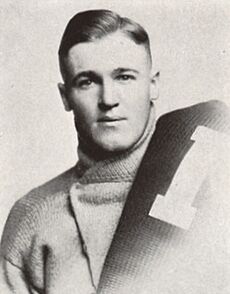
| Name | Position | Tenure | Inducted |
|---|---|---|---|
| Link Lyman | OT | 1918–1919, 1921 | 1964 |
| Guy Chamberlin | E | 1913–1915 | 1965 |
| Bob Brown | OT | 1961–1963 | 2004 |
| Will Shields | OG | 1989–1992 | 2015 |
| Mick Tingelhoff | C | 1959–1961 |
Active Players and Coaches
There are 19 former Cornhuskers currently on NFL rosters. Three former Cornhuskers are also NFL coaches.
Players
- Ameer Abdullah – RB, Las Vegas Raiders
- Omar Brown – S, Green Bay Packers
- Maliek Collins – DL, San Francisco 49ers
- Lavonte David – LB, Tampa Bay Buccaneers
- Khalil Davis – DT, San Francisco 49ers
- Nick Gates – C, Philadelphia Eagles
- Luke Gifford – LB, Tennessee Titans
- Lamar Jackson – CB, Atlanta Falcons
- Brenden Jaimes – OL, Los Angeles Chargers
- Cam Jurgens – OL, Philadelphia Eagles
- Ochaun Mathis – LB, Philadelphia Eagles
- Stanley Morgan Jr. – WR, Tennessee Titans
- Quinton Newsome – CB, Denver Broncos
- Trey Palmer – WR, Tampa Bay Buccaneers
- Ben Stille – DL, Arizona Cardinals
- Jack Stoll – TE, Miami Dolphins
- Cam Taylor-Britt – CB, Cincinnati Bengals
- Samori Toure – WR, Chicago Bears
- Travis Vokolek – TE, Arizona Cardinals
Coaches
- Daniel Bullocks – defensive backs, San Francisco 49ers
- Carlos Polk – asst. special teams, Chicago Bears
- Zac Taylor – head coach, Cincinnati Bengals
Future Games
Nebraska plays one protected rival, Iowa, every year in the Big Ten. The other eight conference games change each year.
| Year | Non-conference opponents | Home conference opponents | Away conference opponents |
|---|---|---|---|
| 2025 | Cincinnati (at Arrowhead Stadium), Akron, Houston Christian | Michigan, Michigan State, Northwestern, USC, Iowa | Maryland, Minnesota, UCLA, Penn State |
| 2026 | Ohio, Bowling Green, North Dakota | Indiana, Maryland, Ohio State, Washington | Illinois, Iowa, Michigan State, Oregon, Rutgers |
| 2027 | Northern Illinois, Miami (OH), Northern Iowa | Iowa, Minnesota, Oregon, Purdue, Rutgers | Northwestern, Ohio State, Washington, Wisconsin |
| 2028 | UTEP, South Dakota State, Arizona | Northwestern, Penn State, UCLA, Wisconsin | Iowa, Michigan, Minnesota, Purdue, USC |
| 2029 | at Oklahoma | TBA | TBA |
| 2030 | South Dakota State, Oklahoma | ||
| 2031 | at Arizona | ||
| 2032 | Cincinnati | ||
| 2033 | TBA | ||
| 2034 | Oklahoma State | ||
| 2035 | at Oklahoma State |


